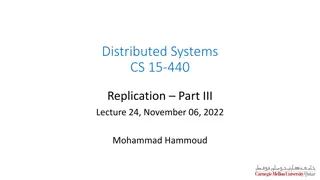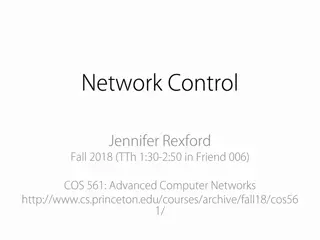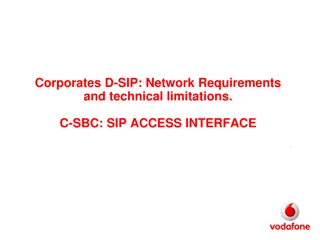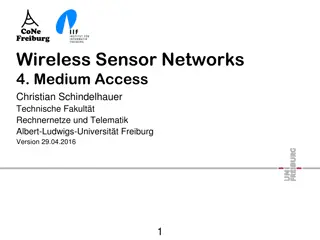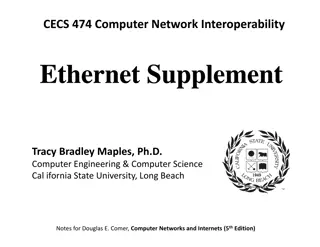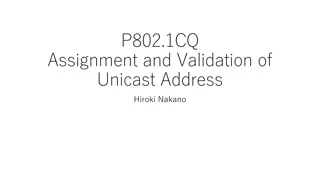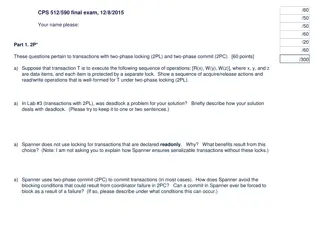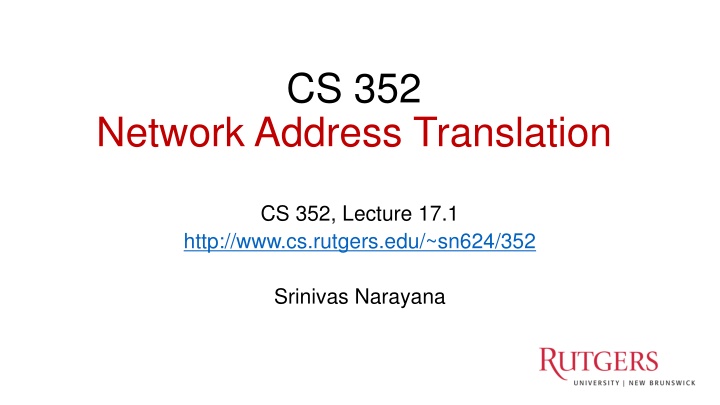
Network Address Translation in Computer Networks
Explore the concept of Network Address Translation (NAT) in computer networks, which enables communication across networks with different addressing formats. Learn how NAT allows networks to use fewer public IP addresses by masquerading private endpoints and how routers modify IP packet fields to achieve this. Dive into typical NAT setups and the challenges associated with IPv4 address exhaustion.
Download Presentation

Please find below an Image/Link to download the presentation.
The content on the website is provided AS IS for your information and personal use only. It may not be sold, licensed, or shared on other websites without obtaining consent from the author. If you encounter any issues during the download, it is possible that the publisher has removed the file from their server.
You are allowed to download the files provided on this website for personal or commercial use, subject to the condition that they are used lawfully. All files are the property of their respective owners.
The content on the website is provided AS IS for your information and personal use only. It may not be sold, licensed, or shared on other websites without obtaining consent from the author.
E N D
Presentation Transcript
CS 352 Network Address Translation CS 352, Lecture 17.1 http://www.cs.rutgers.edu/~sn624/352 Srinivas Narayana 1
Network Application FTP HTTP HTTPS SMTP DNS Transport UDP TCP IP Network X.25 802.11 ATM Host-to-Net The main function of the network layer is to move packets from one endpoint to another.
Background: The Internets growing pains Networks had incompatible addressing IPv4 versus other network-layer protocols (X.25) Routable address ranges different across networks Entire networks were changing their Internet Service Providers ISPs didn t have to route directly to internal endpoints, just to the gateway IPv4 address exhaustion Insufficient large IP blocks even for large networks Rutgers (AS46) has > 130,000 publicly routable IP addresses IIT Madras (a well-known public university in India, AS141340) has 512 (Source: ipinfo.io)
Network Address Translation When a router modifies fields in an IP packet to: Enable communication across networks with different (network- layer) addressing formats and address ranges Allow a network to change its connectivity to the Internet en masse by modifying the source IP to a (publicly-visible) gateway IP address Masquerade as an entire network of endpoints using (say) one publicly visible IP address Effect: use fewer IP addresses for more endpoints!
Typical NAT setup local network 10.0.0/24 rest of the Internet 10.0.0.1 10.0.0.4 10.0.0.2 Gateway router 10.0.0.3 138.76.29.7 The gateway s IP, 138.76.29.7 is publicly visible The local endpoint IP addresses in 10.0.0/24 are private All datagrams leaving local network have the same source IP as the gateway
Typical NAT setup local network 10.0.0/24 rest of the Internet 10.0.0.1 10.0.0.4 10.0.0.2 Gateway router 10.0.0.3 138.76.29.7 That is, for the rest of the Internet, the gateway masquerades as a single endpoint representing (hiding) all the private endpoints. The entire network just needs one (or a few) public IP addresses.
Typical NAT setup local network 10.0.0/24 rest of the Internet 10.0.0.1 10.0.0.4 10.0.0.2 Gateway router 10.0.0.3 138.76.29.7 The NAT gateway router accomplishes this by using a different transport port for each distinct (transport-level) conversation between the local network and the Internet.
Typical NAT setup 1: host 10.0.0.1 sends datagram to an external host, 128.119.40.186, at port 80 2: NAT router changes datagram src addr, port from 10.0.0.1, 3345 to 138.76.29.7, 5001, Updates table Translation table Internet-side Local side 138.76.29.7, 5001 10.0.0.1, 3345 4: Map back S: 10.0.0.1, 3345 D: 128.119.40.186, 80 1 2 S: 138.76.29.7, 5001 D: 128.119.40.186, 80 10.0.0.1 S: 128.119.40.186, 80 D: 10.0.0.1, 3345 4 3 S: 128.119.40.186, 80 D: 138.76.29.7, 5001 10.0.0.2 4: NAT gateway changes datagram dest addr, port from 138.76.29.7, 5001 to 10.0.0.1, 3345 10.0.0.3 3: Reply arrives to dst addr, port 138.76.29.7, 5001
Features of IP-masquerading NAT Use one or a few public IPs: You don t need a lot of addresses from your ISP Change addresses of devices inside the local network freely, without notifying the rest of the Internet Change the public IP address freely independent of network-local endpoints Devices inside the local network are not publicly visible, routable, or accessible Most IP masquerading NATs block incoming connections originating from the Internet Only way to communicate is if the internal host initiates the conversation 9
If youre home, youre likely behind NAT Most access routers (e.g., your home WiFi router) implement network address translation You can check this by comparing your local address (visible from ifconfig) and your externally-visible IP address (e.g., type what s my IP address? on your browser search bar)
Limitations of IP-masquerading NATs Connection limit due to 16-bit port-number field ~64K total simultaneous connections with a single public IP address NAT can be controversial Routers should only manipulate headers up to the network layer, not modify headers at the transport layer! Application developers must take NAT into account e.g., peer-to-peer applications like Skype Purists: address shortage should instead be solved by IPv6 (subject of the next module) 12
CS 352 Internet Protocol: Version 6 CS 352, Lecture 17.2 http://www.cs.rutgers.edu/~sn624/352 Srinivas Narayana 14
IPv4 address space exhaustion The Internet has run out of IPv4 address blocks to allocate Yet, demand for more (public) IP addresses is increasing More organizations moving online, new services, more replication More devices: your phone, your watch, your smart refrigerator Fundamental issue: 32-bit addresses are not numerous enough IP version 6 (IPv6)
IPv6: Main changes from IPv4 Large address space: 128-bit addresses (16 bytes) Allows up to 3.4 x 1038 unique addresses Fixed length headers (40 bytes) Improves the speed of packet processing in routers IPv6 options processing happens through a separate mechanism: using the field corresponding to the upper-layer protocol New control message protocol: ICMPv6 No datagram fragmentation The ICMPv6 packet too big control message informs the source
IPv6: Main changes from IPv4 New quality of service bits: flow label and traffic class Flow label: denotes packets belonging to the same conversation How the field is populated (ie: what exactly belongs to a flow ) isn t specified Routers may choose to provide performance guarantees to flows of specific traffic classes (more on this later) No IP checksum: remove redundant error detection mechanisms Checksums exist already on common transport (TCP/UDP) and link layer (Ethernet) headers
IPv6 datagram format Version: 6 Class and flow label: for traffic differentiation at routers Next header: same as the upper- layer protocol in IPv4. Also used to include IPv6 options Hop limit: same as TTL in IPv4 class ver flow label hop limit payload len next hdr source address (128 bits) destination address (128 bits) 32 bits
IPv6 datagram format Version: 6 Class and flow label: for traffic differentiation at routers Next header: same as the upper- layer protocol in IPv4. Also used to include IPv6 options Hop limit: same as TTL in IPv4 class ver flow label hop limit payload len next hdr source address (128 bits) destination address (128 bits) data 32 bits
Can you spot the differences? type of service hdr len ver length fragment offset class ver flow label flags 16-bit identifier time to live hop limit payload len next hdr upper protocol header checksum source address (128 bits) destination address (128 bits) 32-bit source IP address 32-bit destination IP address Options (if any) data data 32 bits (variable length, typically a TCP or UDP segment) 32 bits
IPv6 addresses IPv6 uses IPv4-CIDR-like (classless) addressing Notation: xx:xx:xx:xx:xx:xx:xx:xx x = 4-bit hex number Contiguous 0s are compressed: 47CD::A456:0124 An IPv4-compatible IPv6 address has a prefix of 96 0-bits Example: ::128.64.18.87 Globally routable unicast addresses must start with bits 001 CIDR prefixes written the usual way: Example: 2000::/48 can contain 280 endpoints
Source: https://www.google.com/intl/en/ipv6/statistics.html#tab=ipv6-adoption IPv6 adoption When IP became a mainstream network-layer protocol, IPv4 was baked into router hardware. Now, about 1/3rd of Internet hosts (contacting Google) support IPv6. IPv6 adoption has been trending up. ~0% of Internet hosts used IPv6 for a long time (about 30 years) In 2012, Google and a bunch of large orgs decided to support IPv6 irrevocably.
CS 352 Address Resolution Protocol CS 352, Lecture 17.3 http://www.cs.rutgers.edu/~sn624/352 Srinivas Narayana 24
Background: Lets peek into the link layer Each network adapter has a hardware address or a MAC address E.g., the Wi-Fi adapter on your laptop has one Assigned by the manufacturer, not expected to vary over time Think about it as an identifier for the device To communicate over a single link, a sender needs the destination hardware address Directory mechanisms like DNS and bootstrapping mechanisms like DHCP provide IP addresses Given an IP address, how does an endpoint find the hardware address?
Address Resolution Protocol (ARP) ARP solves the following problem. Given an IP, find the machine s hardware address IP MAC resolution All endpoints that are looked up are expected to be within the same network Hence, address resolution can use broadcast: We don t need to develop directory mechanisms like DNS Send (ARP) queries to everyone, asking for a MAC given an IP
ARP packet format Hardware type: link-layer protocol Example: Ethernet (1) Hardware address length: Example: Ethernet = 6 bytes Protocol Type: network-layer protocol Example: IPv4 (0x0800) Protocol address length Example: IPv4 = 4 bytes Operation: ARP request: 1, reply: 2 Sender s addresses Address to be resolved (or response)
ARP operation Hardware type: Ethernet Protocol type: IPv4 Hardware addr length: 6 Protocol addr length: 4 Operation: 2 (reply) Sender hardware addr: 05:23:f4:3d:e1:04 Sender protocol addr: 128.195.1.20 Target HW addr: 98:22:ee:f1:90:1a Target protocol addr: 128.195.1.38 Who has 128.195.1.38? Tell 128.195.1.20 ARP request ARP request broadcast A B C Ethernet Address: 05:23:f4:3d:e1:04 IP Address: 128.195.1.20 Ethernet Address: 12:04:2c:6e:11:9c IP Address: 128.195.1.122 Ethernet Address: 98:22:ee:f1:90:1a IP Address: 128.195.1.38 Wants to transmit to 128.195.1.38 Different target IP address: ignore ARP Matching target IP: send reply
Communicating outside the local net? Suppose endpoint A wants to communicate with endpoint B that is in a different network ARP broadcast outside the local network is too expensive How does one limit the scope of the broadcast? Internet-wide? Besides, the hardware address format used by B s network might be different from that of A s network! ARPs are not meaningful across network boundaries Communicating to a network-external endpoint just means sending the packet to the gateway router Host can know that a destination is external using IP addr and netmask Host can talk to the gateway using DHCP (to get IP) and ARP (to get MAC)
Summary of ARP A useful mechanism to allow hosts inside a network to communicate: ARP protocol helps resolve IP addresses into MAC addresses using a broadcast mechanism Communication outside the local network requires ARP-ing for and sending packets to the gateway


